This spring, the garden I’ve been most impressed with is the one I have spent the least amount of time thinking about and fussing over. Isn’t that the way it is with so many things—just set the ball rolling, get out of the way and wait to be unexpectedly amazed?

The strip of garden that runs along the east side of the house was an afterthought in many ways, even though it is the garden closest to the road and should be a showpiece. When the house was built I threw some shrubs in to hold the soil on the bank—a few doublefile viburnums and some dwarf oakleaf hydrangeas, two of my favorite shrubs. Then last year I extended the garden by building the rock wall, and added some gift irises and a few more little plants as I bought them. Because there are no evergreens it looks pretty bare in winter, but this spring the bank erupted in what turned out, this year, to be a quite nice combination of bloom, leaf shape, and color variation. It’s a very old-fashioned feeling garden, with classic plants that one might find around Grandma’s country cottage.
The first to bloom are the the daffodils in late winter, and I am happy to see that their decaying foliage will soon be hid by the new growth coming in on the shrubs, just as it should be. I particularly love the variegated Solomon’s Seal (Polygonatum odoratum var. pluriflorum ‘Variegatum’) at lower right, below, with its white bell-like blooms and sturdy foliage that remains attractive all season.
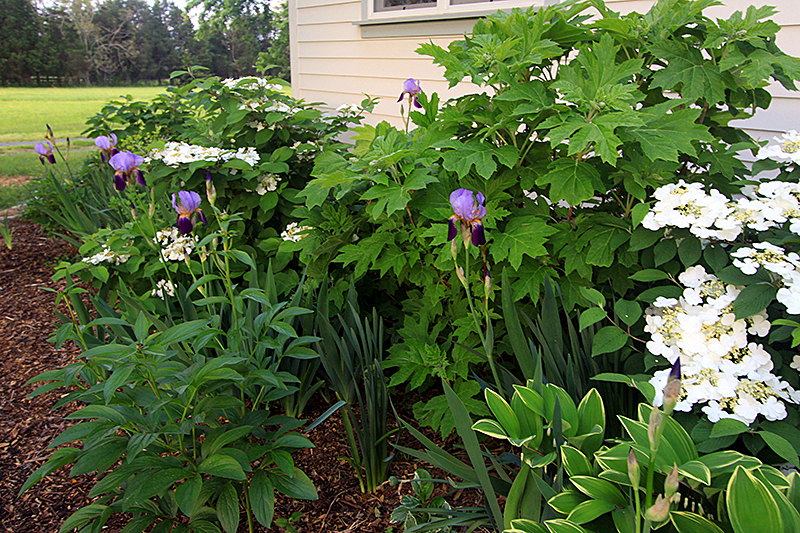
The front corner is anchored by these nice catmints (Nepeta ‘Walker’s Low’), new last year, that continue the lavender bloom color begun by the iris.

The viburnums have finished their bloom, and the irises are soon to say goodbye. I have a few peonies, planted last spring to test if they liked this location, that are budding now. I will see how they look when they bloom, and if I like the effect I will add more peonies to continue the colorful blooms a few more weeks. That should take me until hydrangea time…but after that I will have to figure out what to add to maintain interest here through the dog days of summer until the hydrangeas change into their red leafed costumes for a fall display.
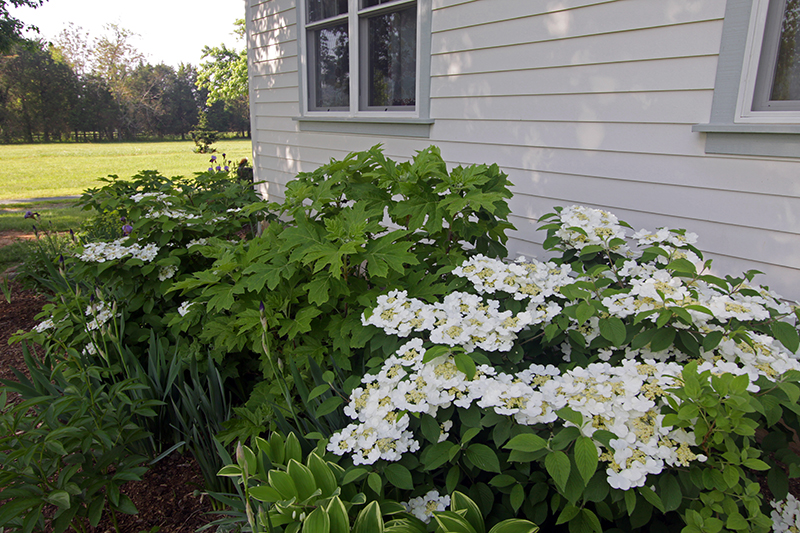
Next fall I will divide the Solomon’s Seal to spread bits of it through the whole garden, and to move it more forward of the shrubs. If I can find something low and pretty all season (maybe some kind of Ajuga, which has purple blooms at the same time as the iris?) to go right along the top of the rock wall, this will really shape up nicely—almost as if I planned it!
And then just when it looks awesome there’s a good chance the shrubs will have grown too large and it will be time to pull them out and start over!
As a way of explaining some of my happiness with this garden’s progress, check out what it looked like just a bit more than a year ago:
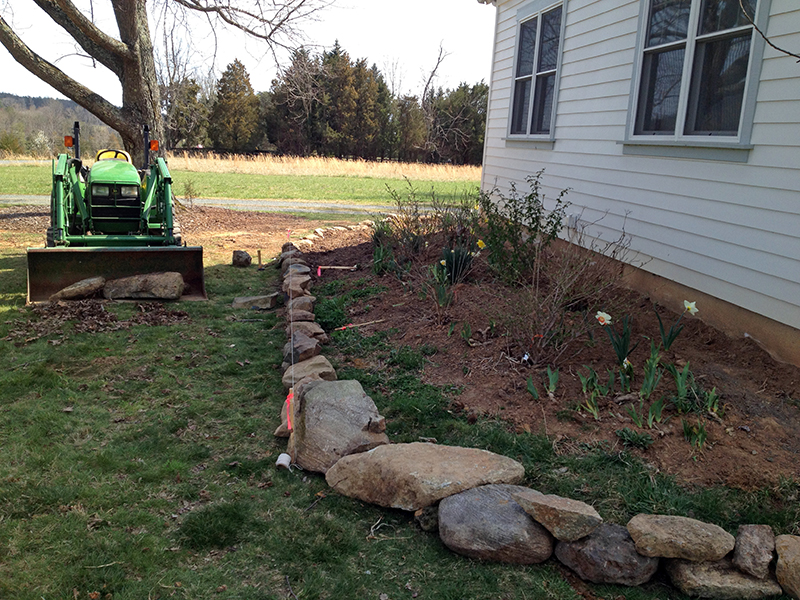
Seeing this photo it’s clear to me that I did the right thing by extending the garden to lessen the slope away from the house, which was making it hard to keep enough water on the shrubs to make them happy, and all the plants responded really well to the back-fill addition of forest-dug compost and a thick blanket of mulch. The border is deep enough (10 feet) that I am able to enjoy the show from inside the house, looking out through the windows, which is an aspect that is so enjoyable but that few consider when creating foundation plantings.
Well the day I was anticipating arrived. Free ranging chickens in fox country means accepting, and living with, the risk that they’ll not come home one night. I’m surprised it took this long, actually. Just yesterday I was saying I hadn’t seen a fox in so long…
All the chickens were out all day today, roaming around. I left for only a short while this afternoon to go to the grocery. The dog was in the house while I was gone. I got back and saw some chickens in the yard, and all six babies were fine by the bushes. I didn’t count the chickens because they often break up into little groups that hang out in different places.
Tonight I put the babies to bed in the garage, and then noticed that only a few of the big chickens were hanging around the coop. I didn’t think much of it, as I figured the others were elsewhere. But at dusk I went to close the coop and there were only five chickens in there: Calabrese the rooster, Cora, Oregano, and the two Black Copper Marans hens, one of which is Dahlia. It’s never a good sign when the chickens don’t come home to roost.
So I got a flashlight and poked around all their favorite hidey holes before steeling myself for a trip into the woods. I knew what I would find, in some state or another. The chickens had taken to raiding the compost pile, which is set just into the woods, which is technically fox territory. I tried to keep it hidden from the birds, but once they discovered the delicious worms and solider fly larvae and food scraps, it became a place they visited several times a day.
Along the path into the woods, right where the snake appeared Monday, I found my first clump of black feathers. Then many, many more all the way to the compost pile. So that’s either Lilac or Iris, or both. The two Lavender Orpingtons are missing as well, but I didn’t find any of their feathers yet. I called for them, hoping they’d be hiding or injured and I could get them home and patch them up. It was getting dark and I didn’t really feel like hunting for more feather piles after finding the first. I just can’t understand that if it was a fox, how did it get four birds at once? I don’t know if foxes hunt in packs—I didn’t think so but I could be wrong. I would have expected them to grab one bird while the others ran for cover. And were was my rooster in the fray? I have seen him run across the entire pasture in response to a hen squawk. Maybe he was too far away?
Like I said, I knew this was coming. It’s one of the reasons why I wanted to raise up some babies this summer, as replacements for the inevitable casualties. And part of me is glad to be rid of the Lavender Orpingtons, mean as it sounds. One didn’t lay reliably, and the other always lay on the floor of the coop (which meant the dog got those eggs) and both of these hens always looked dirty and scraggly (despite baths, the last of which I just gave two nights ago). So no big loss there. But my egg production machine took a big hit with this loss of 2-4 eggs a day. Now I have only the Black Copper Marans as steady layers, as Cora never lays and Oregano does only when the mood strikes her. And it will be next spring until the new hens start laying, provided they don’t get eaten too.
I am a bit sad about Lilac and Iris. They were my first hens and really steady layers of distinctive eggs. They always looked clean and healthy. At their last molt their facial feathers had grown in white, which gave them a cute elderly look. They were in their second year of lay, which means they weren’t spring chickens but they were keeping up with the younger birds. Iris raised a flock of guineas as her own. Lilac’s chick is one of the six babies. And they had good personalities, steady and friendly, and were always the first to come running for treats. They ate copious numbers of bugs and fertilized the gardens, all while getting to live in the fresh air and sun and do whatever they wanted during the day while being protected at night. They had a rooster who loved them. I guess they had pretty wonderful lives.
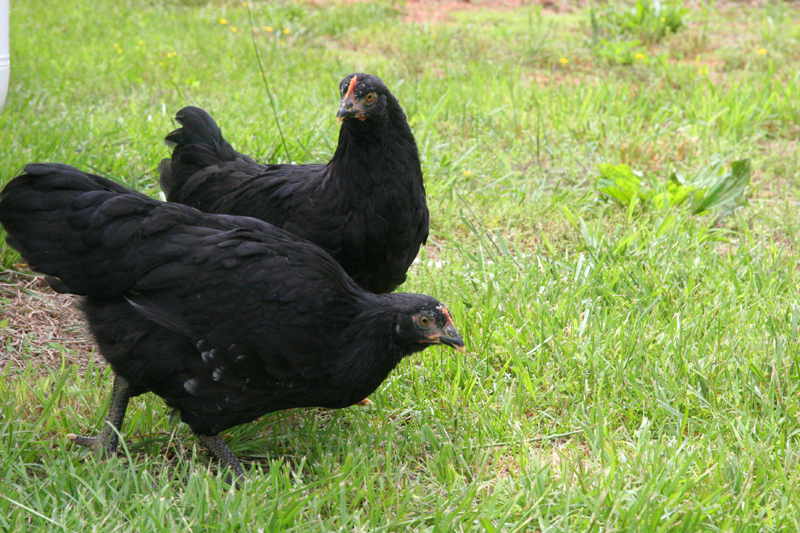
Here they are when I first got them. They were about the age of the baby chicks I have now. And here’s Lilac just two evenings ago, right up front, looking for handouts.
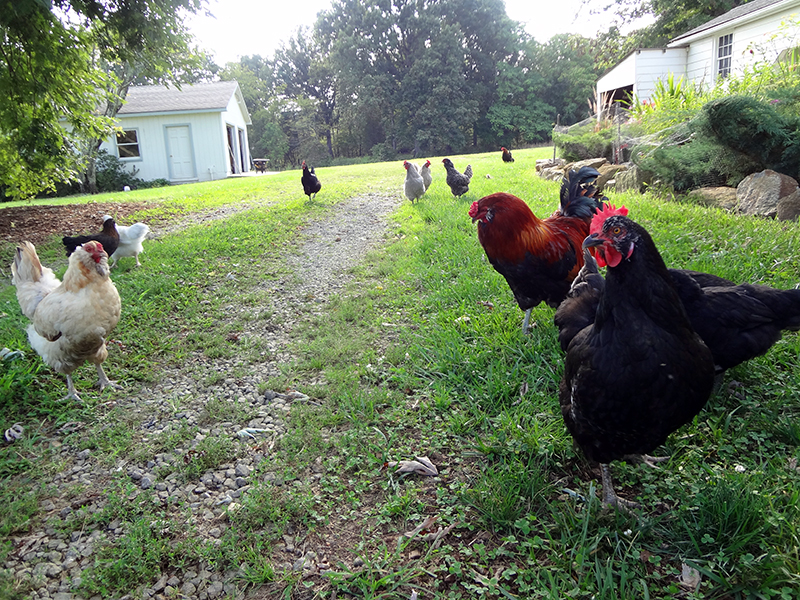
They were good chickens, but now they’re just stories and photos on the pages of this blog.
Goodbye, girls.







